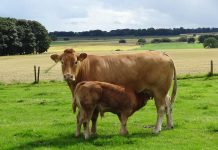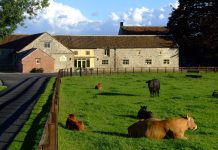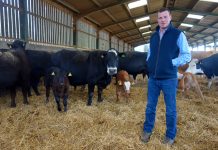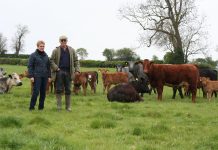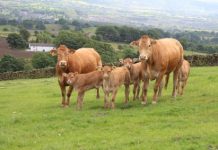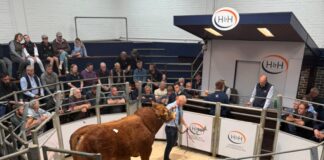A desire to reduce disease risk and improve calf quality has seen Pluckley, Kent-based suckler herd manager Martin Russell progress towards a near purebred Limousin herd over the last six years, with the intention of maximising profitability.
Managing a herd of 325 sucklers for farming and contracting company FGS Agri, Mr Russell is clear that a switch to retaining homebred Limousin-sired replacement heifers was the right route to take when he took over the herd’s management. “We’ve expanded cow numbers rapidly in the last five years, both by acquisition and by retaining our own replacements.
Limousins are Ideal Replacements
“This year we’ll put 270 cows and 55 heifers to the bull with the intention of calving 300 next spring. It’s a big herd and that means everything has to be right. Retaining our own Limousin-sired replacements helps on a number of fronts, but primarily it cuts out the risk of bringing in disease from elsewhere and that is a big bonus in such a large herd.”
Additionally, Mr Russell says homebred replacements can be selected from the better breeding cows in the herd and this gives some indication of future performance in the herd. “If we were buying in replacements we could be buying in cattle of unknown quality and background and that could mean buying poor milkers or bad mothers. By keeping our own we know we’re picking from the cows that have performed for us in the past.”
Limousin bulls are sourced locally, with a number coming from Brian Baker’s Wealden Herd and others from Sue Watson’s Thorndean Herd. “Again, buying off-farm helps reduce the disease risk that comes with buying through sales where bulls can potentially pick up a number of diseases. The herd is BVD free and is vaccinated against leptospirosis and IBR. We’ve tested for BVD continually and have remained free, but I think we’ll have to switch to vaccinating for it in the next year or so as there’s always a risk of mixing with neighbouring cattle.”
Mr Russell says that as well as the health benefits of buying off-farm he also feels he’s getting better bulls as a result. “It means we can see the bull’s mother and generally speaking bulls sourced from home aren’t pushed as hard as those brought out to sales.
“Keeping our own replacements means we want milky females, but we also want cows with udders which last. Being able to see a bull’s mother gives a good indication of how milky his daughters might be and also helps gauge the quality of the bag they may have in years to come. Good tight bags are feature of the Limousin breed and one we want to maximise in our herd.
Additionally, I want bulls to last, so I’d rather they weren’t fed too heavily early in life. We’ve one bull here now which is pushing on for 12 years old and that says a lot about the type of bull I want to work with.”
Tight Calving Pattern
And fit, active bulls are central to the aim of a compact calving pattern too, he says. “This year we calved everything in 12 weeks and the aim for next year is to calve inside of 10 weeks. The herd is all spring calving and such a tight calving pattern means it’s a busy time, but it is important to have evenly grouped calves and it makes cow and calf management much easier if calving is tight.”
To help maintain this tight calving pattern Mr Russell fertility tests every bull every year prior to use to ensure they are up to the job and where necessary replaces bulls not up to scratch. “We are quick to cull poor performing cows, too, and anything not getting in calf inside the service period is culled as there isn’t time to carry passengers in a herd of this size.”
While the drive towards purer Limousin cows has been achieved by using high quality bulls, the herd also carries a dose of native breeding in the form of Sussex blood, he says. “We aren’t always running cows on the best ground and having a bit of native blood in the cows helps them keep their condition better and milk better off some of our poorer grassland. The Limousin cow is good at holding her condition and, with the addition of some native breeding, can really thrive off poorer grassland,” he explains.
“We’re diluting the native blood a bit now, so it may be that we need to re-introduce a Sussex bull in the next few years, the challenge will be to do it without losing the performance, growth and shape we’ve gained with the higher proportion of Limousin breeding in the herd now. We’ve also still got a number of other Continental breed cows in the herd and we have to feed these on the finishing ration when they are housed to get them fit to calve. Increasing the Limousin content of the herd and mixing it with a dash of native blood will help avoid this in future.”
Cost-effective Finishing
But, with most cattle finished on-farm, having a store animal that can finish quickly on a cost-effective ration is an important factor in the herd’s management. Cattle are weaned at housing, with cows wintered on hay or grass silage and calves moved in to a store ration to grow frame before finishing.
“We creep feed calves at grass through the summer so they’re well grown when they come in and then they move onto the growing ration which is based on maize silage and rapemeal with ad-lib grass silage, too.
“Then once they’ve got the frame, we move them onto the finishing ration which is based on potatoes, maize silage and straw. Other suitable ingredients are included as required and I’m not a big fan of feeding maize silage through the summer as it can go off very quickly in the heat.”
The aim is to finish cattle from 16-22 months old, with all finished and cull cattle sold on a deadweight basis to ABP Guildford, with steers aimed at about 380kg deadweight. “We do sell up to 50 calves a year as stores through the local market at Ashford if the trade is right. The last couple of years have seen a strong store trade and it has been tempting to sell a lot more, but we’re earning well from finishing good quality Limousin crosses, so there’s no need to consider it just at the moment.”
Looking ahead, Mr Russell says his continued quest to maintain a high health herd could see a switch to breeding his own bulls, too. “It may be that we set up a small nucleus herd to breed replacement bulls and use AI to access the best genetics possible for this herd. While we’ve narrowed down the disease risks quite well already there is always a risk when bringing any animal in to the herd and that’s something we have to be acutely aware of.
“Any disease breakdown could affect the herd significantly and we’d also be able to rear bulls less intensively than many breeders would want to. We’re looking for shape and milk in a bull, but without excessive feeding to get flesh on them.”
A trial group of heifers have also been bulled to calve at two years old next spring, too, with Mr Russell keen to reduce calving age if possible. “We’ve historically calved at three years old, but that means having a group of heifers running empty for a year. If we can calve at two it will simplify management and help improve returns,” he adds.
“Our well-grown Limousin-sired heifers should be more than capable of calving at two years old and rearing a good calf in their heifer year.”










